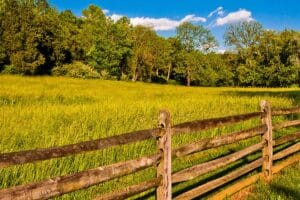Land: What is Land?
Land is everything beneath us. Land is a basis of wealth and is handed down through generations as a possession of great value. Land cloths us, feeds us, and provides for our homes. Land provides life for every living thing. Land has not been produced in millions of years yet it is so common. Land is the safest collateral.
Types of Land:
Land has many purposes. As a provider of food, you have agriculture land. For wood products, you have forest land. Mining land provides minerals and metals. Parks and Land Preserves provide habitat for all living things. Recreational land provides for human pleasures and exploration. Ranch and pasture land provides grazing for animals. Rural land provide for less dense living. Urban land supports commercial, home, and limited recreational usage.
Land as an investment:
There are many types of land investments. In fact, all land acquisitions are investments whether held for a short time or extended periods or even generations. Every real estate investment always starts with land whether you were involved with the land or are now involved with the bricks. ALL structures have a foundation on land.
Land is constantly increasing in value driven by the ever increasing world population. Population growth creates a constant demand for new development, more agriculture products, more timber, steal, oil, minerals, etc. But land that has the most demand is development land for homes, businesses, schools, recreation, and other population demands.
Learning how to identify these areas can be obtained by observation, inquiries, and knowledge of future growth patterns. Land development creates trends and trends can be followed. For example: new industry creates retail which creates housing. Watching where new industrial sites are being planned may help identify such land that may have future potential. Investing in land outside an urban area where new highways, infrastructure, and annexation, are planned could be an indicator of potentially higher land prices in the future. W.C Fields said: “If you know where the people are going, get there before they do.” The earlier you invest into land, the more you will be rewarded at a later time. Building good strategies and a little risk can be very rewarding. Do not forget your Land Pro contact. They will help make your investment decisions easier.
Land vs. Residential investments:
Buying an investment home can have a lot of strings attached. Rehabbing and workmanship issues, termites, radon gas, lead based paint, etc. (Now rented, tenants issues like fix this, sorry I am late on my rent and then try and get them out and hope they did not destroy the place.) What happens when the economy takes a severe downturn and you are unable to rent the property? Those mortgage payments are still due.
Land has no tenants, no maintenance, no complaints, only the pleasure of walking upon it and watching it grow in value. Waiting for that anticipated phone call when a developer says, “I want to buy your land!”
Land stabilizes in value during downturns in the economy. Residential development increases when interest rates decrease. Land also enjoys increases in value during an upward trend in the market, but when the market declines in real value and home values decline, land stabilizes. Land is driven not by economic pressures, but by population growth. The ever increasing population keeps constant pressure on the need for more developable land. When the interest rates decline, the gates are open for more development and the pent up supply of land is now in higher demand.
Financing Land:
Money lending is a calculated risk. Home mortgages have lower interest rates due to the fact that the lending industry feels if you have a home mortgage, you will probably get up everyday, go to work and make your mortgage payment on time; probably because you sleep there.
Vacant land loans carry more risk. The assumption is that you do not sleep there and will make your home mortgage before you would make your land mortgage if you were positioned to make a choice. Therefore, you will usually see about a 2% higher interest for a land loan as opposed to a traditional 30 year fixed mortgage.
Farm Credit, “The Land Bank” down payment requirements for land are 15% down, and will usually only extend no more that a 20 year term mortgage. Other lending sources may require more down payment and have shorter terms.
Any real estate that has five or more acres is considered “non-conforming” in the mortgage industry nationwide. The mortgage industry prefers bricks and less land. Depending on your goals, you can tie up a lot of assets with little cash. Consider investing money in Wall Street and you call up your broker and say, “I would like to buy $100,000.00 in stock and will pay 15% down.” If you have short range goals, you may want to fully leverage your land purchase. If you have further long range goals, you may want to pay cash or finance less. “Time value of money” will make that decision clearer.
“Highest & Best” Use of Land:
What you see is not necessarily what you get. A simple example is you purchase 10 acres of land for $50,000.00. This bounty has lots of state road frontage and lays well. The county “Sub-Division” laws say you may subdivide land into one acre tracts or 43,560 square feet lots. The average lot in this market is selling for $15,000.00 per one acre lot. Is the investment worth $50,000.00 or $150,000.00?
Learning how to recognize the potential of a tract of land is very important. Reviewing and understanding the “Sub-division laws” a must read. Knowing how to play the game starts with that affidavit.
The Out Strategy for Land:
Land is as liquid as any other type of real estate despite what the critiques say. Entering into a land investment should not be callus. If you plan to purchase ten rental properties or light commercial warehouse space, you probably spend a lot of time analyzing that investment. Land is no different. Good initial planning for the use of the land, observing the market trends, holding ability and “Highest & Best” use plan will strengthen your position.
Using the example above, a bail out strategy may be selling off two lots now at a lower anticipated price and maintaining the balance of the inventory until the market turns. Auctions which are a quick, usually 30 day close, may be one approach. Subordination can be another way to speed up your return. The initial research and planning are as important in land investments as they are with any other type of real estate investment.
This content may not be used or reproduced in any manner whatsoever, in part or in whole, without written permission of LANDTHINK. Use of this content without permission is a violation of federal copyright law. The articles, posts, comments, opinions and information provided by LANDTHINK are for informational and research purposes only and DOES NOT substitute or coincide with the advice of an attorney, accountant, real estate broker or any other licensed real estate professional. LANDTHINK strongly advises visitors and readers to seek their own professional guidance and advice related to buying, investing in or selling real estate.









Nice article, Lou. Very informative and interestingly written.
H Steve,
Thank you for your comments. Land is so important in the overall market. Maybe someday more people will appreciate what Land truly is and what it provides as well as the great long term investment benefits.
Buy as much as you can afford.
Lou Jewell ALC
Pls i want to more the definition of Land thank You
Hi Harrison,
I did not understand your question…Please email me.
Lou Jewell ALC
How is the concept of ‘highest and best use’ allocates land between competing logical users in the land market?
HiJane,
Not sure I understand your question. Can you furnish an example or situation please.